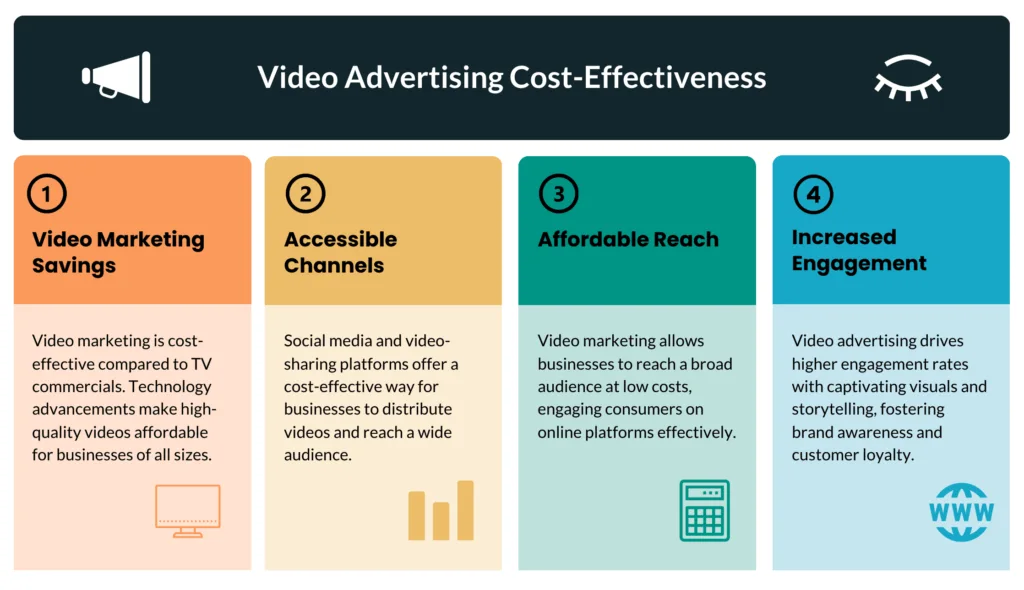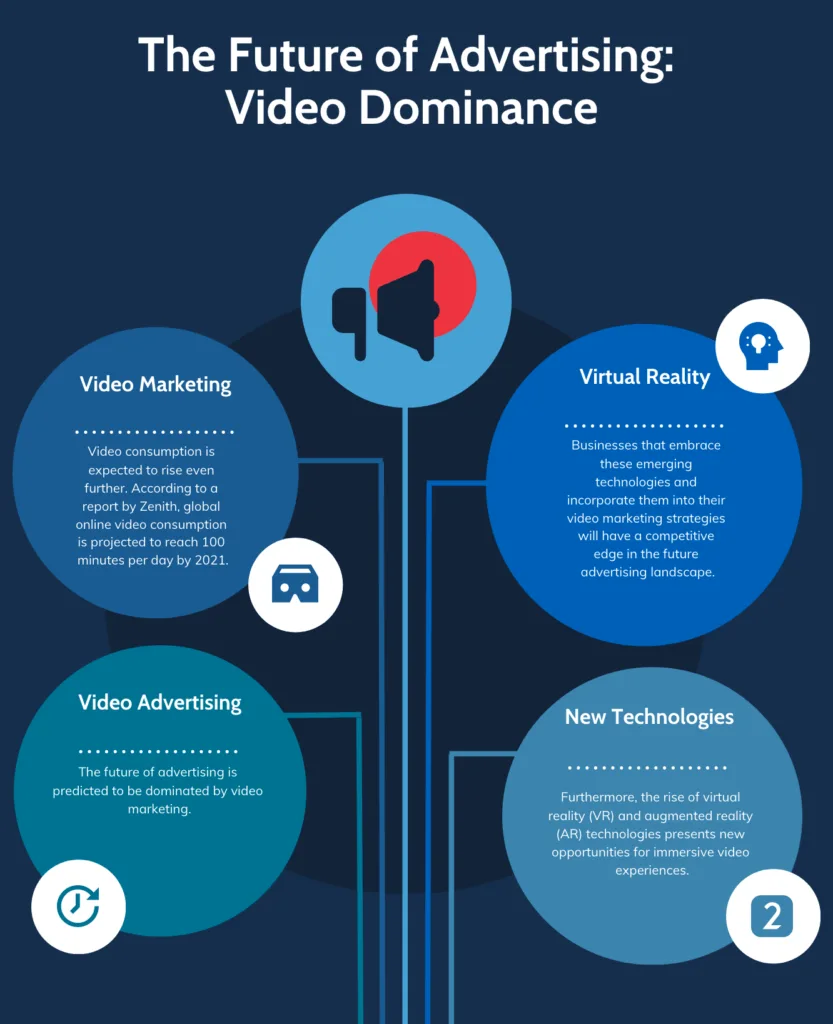Marketing has evolved significantly, with new strategies and techniques constantly emerging.
One such strategy that has gained immense popularity in recent years is video marketing.
This blog post aims to explore the rise of video marketing, its impact on consumer behavior, its effectiveness in building brand awareness, its advantages for SEO, and its cost-effectiveness compared to other forms of advertising.
Key Takeaways
- Video marketing is on the rise and is more effective than text ads.
- Text ads have limitations and cannot convey emotions and visual storytelling like videos can.
- Video marketing has a powerful impact on consumer behavior and can create emotional connections with viewers.
- Video is effective for building brand awareness, improving SEO, and social media marketing.
- Video advertising is cost-effective and the future of advertising is dominated by video. Successful video marketing requires planning, creativity, and a clear message.
The Rise of Video Marketing
Video marketing has experienced exponential growth in recent years.
According to a report by Cisco, by 2022, online videos will make up more than 82% of all consumer internet traffic.
This staggering statistic highlights the increasing popularity of video as a medium for communication and marketing. The rise of video marketing can be attributed to several factors.
Videos have the ability to capture and retain viewers’ attention more effectively than text-based content. With the average attention span of internet users decreasing, businesses are turning to video marketing to engage their target audience.
Additionally, the widespread availability of high-speed internet and the proliferation of smartphones have made it easier for people to consume video content on the go.
The Limitations of Text Ads

While text ads have been a staple in the advertising industry for decades, they do have their limitations.
Text ads rely solely on written content to convey a message, which can be restrictive when trying to create an emotional connection with the audience. Furthermore, text ads often lack the visual appeal that videos offer.
When comparing text ads to video marketing, it becomes evident that videos have a distinct advantage.
Videos allow for visual storytelling, enabling businesses to convey their message more engagingly and memorably. By combining visuals, audio, and storytelling techniques, video marketing has the power to captivate viewers and leave a lasting impression.
The Power of Visual Storytelling
One of the key strengths of video marketing is its ability to tell stories visually.
Visual storytelling is a powerful tool that can evoke emotions, create connections, and leave a lasting impact on viewers. Through video marketing, businesses can take their audience on a journey, immersing them in a narrative that resonates with their brand and values.
Numerous successful examples of visual storytelling in video marketing exist. Take, for instance, the Dove Real Beauty campaign.
Through a series of videos, Dove aimed to challenge societal beauty standards and promote self-acceptance. By telling stories of real women and their struggles with body image, Dove created an emotional connection with viewers, ultimately strengthening their brand and increasing consumer loyalty.
The Impact of Video on Consumer Behavior

Video marketing has a profound impact on consumer behavior.
Studies have consistently shown that consumers are more likely to make a purchase after watching a video about a product or service. This trend is supported by Wyzowl’s State of Video Marketing report, which reveals that 84% of consumers have been convinced to buy a product or service after watching a brand’s video.
The effectiveness of video marketing can be attributed to its ability to engage multiple senses simultaneously.
Unlike text-based ads, videos combine visual and auditory elements, creating a more immersive experience for the viewer. This multisensory engagement helps to capture and retain the audience’s attention more effectively.
Videos also have the unique advantage of showcasing products or services in action.
This dynamic presentation allows consumers to visualize themselves using the products, making it easier for them to understand the benefits and applications. For instance, a video demonstrating how a kitchen gadget simplifies cooking tasks can be far more persuasive than a written description.
Moreover, videos have the power to evoke emotions, which can significantly influence purchasing decisions.
Emotional responses such as happiness, excitement, or even nostalgia can create a strong connection between the consumer and the brand. By leveraging the emotional impact of videos, businesses can effectively sway consumer behavior in their favor.
The Importance of Emotional Connection

Creating an emotional connection with consumers is crucial for building brand loyalty and fostering long-term relationships.
In today’s competitive market, where consumers are bombarded with countless advertisements daily, standing out requires more than just presenting a product or service. It necessitates forging a bond that resonates on a deeper, emotional level.
Video marketing provides an ideal platform for establishing this connection. Unlike text-based ads, videos can combine visuals, sound, and narrative to create a multi-sensory experience that engages viewers more effectively.
Through videos, businesses can tap into the power of storytelling and evoke emotions that resonate with their target audience. This emotional resonance can lead to increased trust, loyalty, and ultimately, higher conversion rates.
One notable example of emotional video marketing is the Always Like a Girl campaign. This campaign aimed to challenge gender stereotypes and empower young girls by redefining what it means to do something like a girl. By sharing stories of real girls and their experiences, Always successfully created an emotional connection with viewers.
The campaign featured heartfelt interviews and powerful visuals that highlighted the confidence and strength of young girls when they were encouraged to embrace their true selves.
The impact of the Like a Girl campaign was profound. It not only sparked important conversations about gender equality but also strengthened Always’ brand identity as a champion for female empowerment.
Viewers who connected emotionally with the campaign were more likely to develop a sense of loyalty towards the brand. This loyalty translated into increased consumer trust and preference for Always products over competitors.
The Role of Video in Building Brand Awareness
Brand awareness is crucial for businesses looking to establish themselves in a competitive market.
Video marketing plays a significant role in building brand awareness by increasing visibility and reach.
Unlike traditional text ads, videos can capture attention more effectively and convey messages more engagingly.
The dynamic nature of video content allows brands to tell their stories, showcase their products, and connect with their audience on an emotional level.
One of the key advantages of video marketing is its potential to go viral. A well-crafted video can be shared across social media platforms, reaching a wide audience and generating buzz around a brand. This organic sharing amplifies the brand’s message far beyond its initial audience, creating a ripple effect that can significantly boost brand visibility.
Successful brand awareness campaigns using video marketing can be seen in the example of Coca-Cola’s Share a Coke campaign.
Through a series of videos, Coca-Cola encouraged consumers to share their personalized Coke bottles and the stories behind them.
These videos featured real people and authentic moments, making them highly relatable and shareable. By leveraging the power of user-generated content and social sharing, Coca-Cola successfully increased brand awareness and engagement.
Moreover, video marketing allows brands to showcase their unique personality and values. This helps in building a strong brand identity that resonates with the target audience.
For instance, brands can use behind-the-scenes videos to give consumers a glimpse into their operations or create how-to videos that provide value while subtly promoting their products.
Video marketing is an indispensable tool for building brand awareness in today’s digital age. Its ability to engage viewers, encourage social sharing, and convey complex messages in an easily digestible format makes it far more effective than traditional text ads.
Brands looking to establish themselves and stand out in a crowded market should consider incorporating video into their marketing strategies to unlock massive ROI.
The Advantages of Video for SEO
Search engine optimization (SEO) is crucial for businesses looking to improve their online visibility and attract organic traffic. Video marketing offers several advantages when it comes to SEO, making it an essential tool for modern digital marketing strategies.
One of the primary benefits of incorporating videos into your SEO strategy is that videos are more likely to appear on the first page of search engine results.
Search engines, particularly Google, prioritize video content because it tends to engage users more effectively than text alone. This increased visibility can significantly enhance the chances of attracting clicks and driving traffic to your website.
Moreover, videos can substantially increase the time users spend on your website, which is a critical factor in search engine rankings.
When users engage with video content, they are likely to stay longer on your site. This extended dwell time sends a positive signal to search engines, indicating that your content is relevant and valuable. As a result, search engines may boost your website’s ranking in search results.
Additionally, videos can improve user experience by providing information in a more dynamic and engaging format. This can lead to higher user satisfaction and lower bounce rates, both of which are favorable for SEO.
High-quality video content can also encourage social sharing and backlinks from other websites, further enhancing your site’s authority and search engine performance.
Leveraging video content as part of your SEO strategy offers multiple advantages. From improving search engine rankings and increasing website traffic to enhancing user engagement and satisfaction, videos are a powerful tool that can help businesses achieve their digital marketing goals.
The Effectiveness of Video in Social Media Marketing

Social media has become an integral part of many people’s lives, making it an essential platform for businesses to reach their target audience. Video marketing has proven to be highly effective in social media marketing campaigns, offering a dynamic and engaging way to capture the attention of potential customers.
According to HubSpot, social media posts with videos generate 48% more views than those without. This statistic underscores the power of video content in attracting and retaining viewer interest. Videos are inherently more engaging than text or static images because they combine visual and auditory elements, making it easier for viewers to absorb and retain information.
Successful social media video marketing campaigns can be seen in the example of GoPro. GoPro’s YouTube channel features user-generated videos showcasing thrilling adventures and breathtaking moments captured with their cameras. By leveraging user-generated content and sharing it on social media platforms, GoPro has successfully built a community of loyal followers and brand advocates.
GoPro’s strategy involves encouraging customers to share their own experiences using GoPro products, which not only provides authentic content but also foster a sense of community among users. This approach has helped GoPro create a powerful brand presence on social media, driving engagement and increasing brand loyalty.
Moreover, video content is highly shareable, which can significantly extend the reach of your marketing efforts. When users find a video compelling or entertaining, they are more likely to share it with their own networks, amplifying your message beyond your immediate audience.
The Cost-Effectiveness of Video Advertising

Contrary to popular belief, video marketing can be highly cost-effective, especially when compared to traditional forms of advertising such as television commercials.
With advancements in technology, creating high-quality videos has become more accessible and affordable for businesses of all sizes. Gone are the days when producing a professional-grade video required a massive budget and specialized equipment.
Today, even small businesses can create compelling video content using smartphones, affordable editing software, and online resources.
Additionally, the widespread use of social media platforms and video-sharing websites provides businesses with a cost-effective distribution channel for their videos.
Platforms like YouTube, Facebook, Instagram, and TikTok allow businesses to reach a vast audience without the need for expensive advertising campaigns. These platforms offer various tools and features that enable targeted advertising, ensuring that your video content reaches the right audience at the right time.
Moreover, video content tends to have higher engagement rates compared to text-based ads. People are more likely to watch a video than read a lengthy article or advertisement. This increased engagement can lead to higher conversion rates and a better return on investment (ROI). By leveraging the power of video marketing, businesses can not only save on advertising costs but also achieve better results.
Video marketing offers a cost-effective alternative to traditional advertising methods. With the right strategy and tools, businesses can create high-quality videos that engage their audience and drive significant ROI. By utilizing social media platforms and video-sharing websites for distribution, companies can maximize their reach without breaking the bank.
The Future of Advertising: Video Dominance

The future of advertising is predicted to be dominated by video marketing.
As technology continues to advance and internet speeds increase, video consumption is expected to rise even further. According to a report by Zenith, global online video consumption is projected to reach 100 minutes per day by 2021. This trend underscores the growing importance of video content in capturing audience attention and driving engagement.
Video marketing offers a dynamic and engaging way to communicate with audiences. Unlike text ads, videos can convey emotions, tell stories, and demonstrate products in action, making them more memorable and impactful. This ability to create a deeper connection with viewers translates into higher conversion rates and better return on investment (ROI) for businesses.
Furthermore, the rise of virtual reality (VR) and augmented reality (AR) technologies presents new opportunities for immersive video experiences. These technologies allow brands to create interactive and engaging content that goes beyond traditional video formats.
For instance, VR can transport users into a fully immersive environment where they can explore products or services in a virtual space. AR, on the other hand, can overlay digital information onto the real world, enhancing the user’s experience with interactive elements.
Businesses that embrace these emerging technologies and incorporate them into their video marketing strategies will have a competitive edge in the future advertising landscape. By leveraging VR and AR, companies can offer unique and memorable experiences that set them apart from competitors.
Additionally, these technologies provide valuable data on user interactions and preferences, enabling businesses to refine their marketing strategies for even greater effectiveness.
Making the Switch: Tips for Successful Video Marketing

For businesses looking to make the switch to video marketing, there are several tips to keep in mind. Firstly, it is essential to define clear goals and objectives for each video marketing campaign. Whether the goal is to increase brand awareness, drive sales, or engage with the audience, having a clear focus will help guide the creative process.
Businesses should invest in high-quality equipment and production values. While it is possible to create videos with minimal resources, investing in professional equipment and production values can significantly enhance the overall quality and impact of the videos.
It is crucial to analyze and measure the success of each video marketing campaign. By tracking key metrics such as views, engagement, and conversions, businesses can gain valuable insights into what works and what doesn’t, allowing them to refine their strategies for future campaigns.
In conclusion, video marketing has emerged as a powerful tool for businesses to engage their target audience, influence consumer behavior, build brand awareness, improve SEO, and achieve cost-effective advertising. With the rise of video consumption and the increasing popularity of social media platforms, video marketing is predicted to dominate the advertising industry in the future.
Businesses that embrace video marketing and leverage its potential for visual storytelling, emotional connection, and brand awareness will have a competitive advantage in the digital landscape. By making the switch to video marketing and following best practices, businesses can effectively communicate their message, engage their audience, and achieve their marketing goals. It is time for businesses to consider video marketing as an integral part of their overall marketing strategy.
FAQs
What is the main difference between text ads and video marketing?
Text ads primarily rely on written content to convey a message, while video marketing uses visual and auditory elements to engage the audience. Video marketing can often capture attention more effectively and convey complex messages more dynamically than text ads.
Why should I consider video marketing over text ads?
While text ads can be effective, video marketing offers a higher potential for engagement and emotional connection with your audience. Videos can demonstrate products in action, tell compelling stories, and create memorable experiences that text ads may not achieve as easily.
Can I use both text ads and video marketing together?
Absolutely! Combining text ads with video marketing can create a comprehensive advertising strategy. Text ads can drive initial interest and clicks, while videos can deepen engagement and provide more detailed information.
Are text ads still relevant in today’s digital marketing landscape?
Yes, text ads remain relevant and effective, especially for search engine advertising where users are actively looking for specific information or products. However, integrating video marketing can enhance your overall strategy by reaching audiences on platforms where visual content is more engaging.
How do I measure the ROI of video marketing compared to text ads?
To measure the ROI of video marketing versus text ads, track key performance indicators (KPIs) such as click-through rates (CTR), conversion rates, engagement metrics (likes, shares, comments), and overall sales generated from each type of ad. Comparing these metrics will help you understand which format delivers better results for your business.
What platforms are best for running video marketing campaigns?
Popular platforms for video marketing include YouTube, Facebook, Instagram, TikTok, and LinkedIn. Each platform has its own strengths and audience demographics, so choose the ones that align best with your target market. Text ads can complement these efforts by driving traffic to your videos.
How much budget should I allocate to video marketing compared to text ads?
The budget allocation depends on your overall marketing goals and resources. Video production can be more costly than creating text ads due to factors like scripting, filming, editing, and distribution. However, the higher engagement rates of videos often justify the investment.
Can small businesses benefit from video marketing as much as larger companies?
Yes! Small businesses can leverage video marketing effectively by creating authentic, relatable content that resonates with their audience. While large companies may have bigger budgets for high-production videos, small businesses can still achieve significant ROI with creative and targeted campaigns alongside their text ads.
What types of videos work best for marketing purposes?
Different types of videos serve various purposes: explainer videos educate viewers about your product or service; testimonial videos build trust through customer stories; how-to videos provide valuable information; and promotional videos highlight special offers or events. These can all complement your existing text ads strategy.
How do I get started with video marketing if I’ve only used text ads before?
Begin by identifying your goals and target audience for your video campaign. Research what types of content resonate with them and plan your videos accordingly. Start small with simple production techniques if you’re new to video creation—over time, you can invest in higher-quality production as you see results.
Are there any industries where text ads perform better than video marketing?
Text ads tend to perform well in industries where users are actively searching for specific information or solutions—such as legal services or B2B software—because they provide quick access to relevant content through search engines like Google. However, even in these industries, incorporating video content can enhance user experience and engagement.
How do I optimize my videos for better performance compared to my text ads?
To optimize your videos: ensure they are high-quality; keep them concise; include clear calls-to-action (CTAs); use engaging thumbnails; optimize titles and descriptions with relevant keywords; and promote them across multiple channels to reach a wider audience than just relying on text ads alone.
What common mistakes should I avoid when transitioning from text ads to video marketing?
Avoid these common mistakes: neglecting a clear strategy; producing low-quality videos; ignoring SEO best practices; failing to track performance metrics; not engaging with viewers through comments or feedback; and not integrating your video efforts with existing text ad campaigns for a cohesive approach.
Can I repurpose my existing content from text ads into videos?
Yes! Repurposing content from your successful text ads into engaging videos is a great way to maximize resources and maintain consistency in messaging across different formats. For example, you can turn blog posts into explainer videos or transform customer reviews into testimonial clips.




